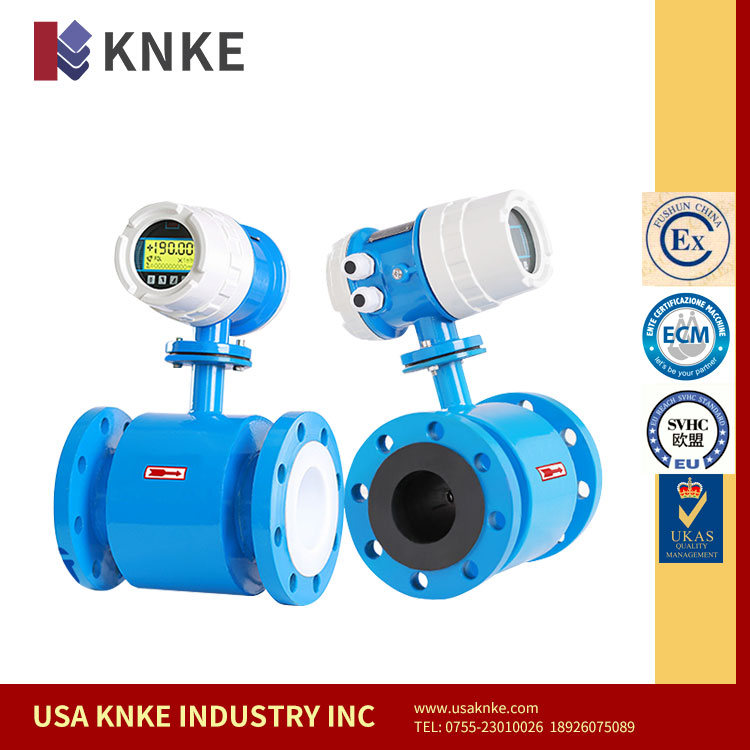Electromagnetic Flow Meter: Principle, Types, Applications & Installation Guide
In industrial process automation, the electromagnetic flow meter (also known as a mag flow meter or magnetic flowmeter) is one of the most reliable instruments for measuring the flow rate of conductive fluids. Its non-intrusive design, high accuracy, and low maintenance requirements make it a preferred choice in water, chemical, food, and environmental industries.
This guide explains the working principle, classification, key applications, and installation & maintenance tips for electromagnetic flow meters to help you choose the right one for your system.
1. What Is an Electromagnetic Flow Meter?

An electromagnetic flow meter (EMF) is a volumetric flow measurement device that determines the flow rate of electrically conductive liquids using Faraday’s Law of Electromagnetic Induction.
Unlike mechanical flow meters, mag flow meters do not contain moving parts, resulting in minimal pressure loss and long-term reliability.
✅ Key Features
- Suitable for conductive liquids and slurries
- No flow obstruction → low pressure drop
- Accurate measurement even for corrosive or dirty fluids
- Supports bidirectional flow measurement
- Maintenance-free design
2. Working Principle of Electromagnetic Flow Meters
The electromagnetic flow meter works based on Faraday’s Law, which states that when a conductive fluid passes through a magnetic field, an electrical voltage is induced proportional to its velocity.
This induced voltage is measured by electrodes positioned along the pipe wall. The electronic transmitter converts this voltage into a flow rate signal.
Formula:
E = k × B × D × V
Where:
- E = Induced voltage
- k = Constant
- B = Magnetic flux density
- D = Electrode spacing (pipe diameter)
- V = Fluid velocity
Thus, the flow rate is directly proportional to the velocity of the fluid and pipe cross-sectional area.
3. Types of Electromagnetic Flow Meters
Electromagnetic flow meters can be classified based on installation type, lining material, and electrode configuration.
(1) Based on Structure
- Inline Type (Full Bore)
Measures full pipe flow with highest accuracy (±0.2%).
Commonly used in water, chemical, and process systems. - Insertion Type
Electrode probe inserted into existing pipeline; ideal for large diameters.
Cost-effective and easy to maintain.
(2) Based on Lining Material
- PTFE / PFA – For strong acids and alkalis
- Rubber – For water, wastewater, and slurry
- Ceramic – For abrasive or high-temperature fluids
(3) Based on Electrode Type
- Fixed electrodes – Standard industrial use
- Self-cleaning electrodes – Used for sticky or dirty fluids
4. Applications of Electromagnetic Flow Meters
Electromagnetic flow meters are widely used in industries where conductive liquids are measured:
- Water & Wastewater Treatment – Flow monitoring, distribution, and leakage detection
- Chemical & Petrochemical – Acid, alkali, and solvent measurement
- Food & Beverage – Milk, beer, juice, and syrup processing
- Pulp & Paper – Pulp slurry and black liquor flow measurement
- Mining & Metallurgy – Slurry and process water monitoring
- Pharmaceutical & Biotechnology – Precise and hygienic flow control
5. Advantages and Limitations
✅ Advantages
- High accuracy (±0.2–0.5%)
- No moving parts → minimal wear and maintenance
- Excellent for viscous, corrosive, or dirty fluids
- Wide pipe size range (DN10–DN3000+)
- Compatible with digital communication (HART, Modbus, Profibus)
⚠️ Limitations
- Cannot measure non-conductive fluids (e.g., oil, pure hydrocarbons)
- Requires full-pipe flow condition for accuracy
- Installation location must avoid strong electromagnetic interference
6. Installation and Maintenance Tips
To ensure long-term stability and accuracy, proper installation is critical.
- Straight pipe length:
- ≥5D upstream and ≥3D downstream (D = pipe diameter)
- Grounding:
- Ensure proper electrical grounding to prevent noise interference
- Orientation:
- Install horizontally; electrodes should be at the same height
- Avoid air bubbles:
- Air pockets cause reading errors
- Regular calibration:
- Calibrate annually or per manufacturer’s instructions
- Periodic cleaning:
- Remove scale or buildup from electrodes if used in dirty fluids
The electromagnetic flow meter is an essential tool in modern industrial automation for precise, reliable, and maintenance-free flow measurement of conductive liquids.
By understanding its working principle, structure, and correct installation practices, you can maximize measurement accuracy and system efficiency.
For high-demand applications, selecting a flow meter with the right lining material, communication protocol, and electrode design is key to long-term performance.
